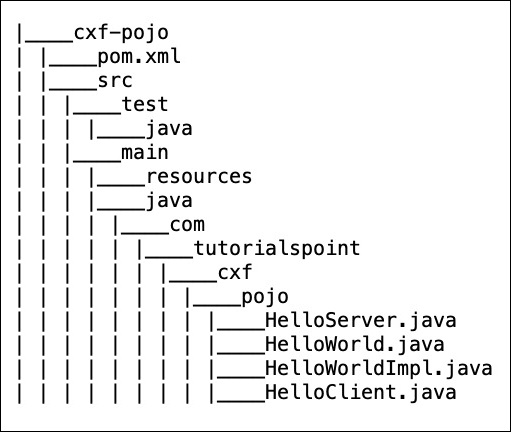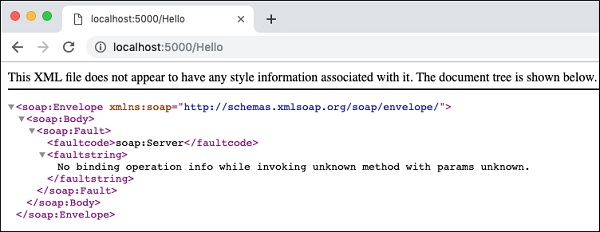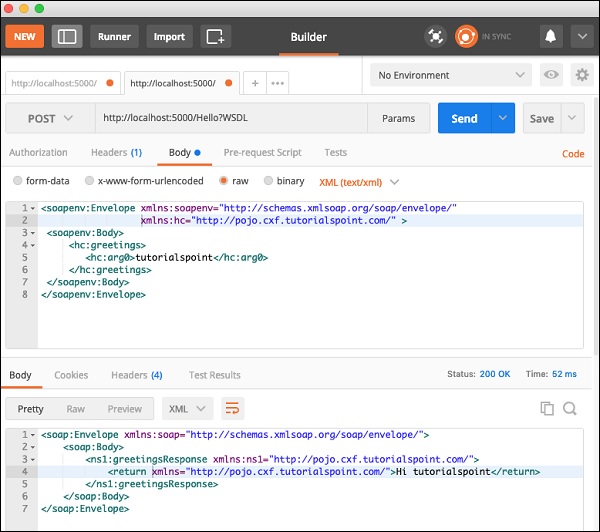Apache CXF 与 POJO
在本章中,您将学习如何开发一个简单的 Web 应用程序来向用户发送问候消息。 Web 服务项目使用 WSDL 模型。 CXF 允许您通过提供一个简单的前端将 Apache CXF API 映射到底层 WSDL 来隐藏此 WSDL 模型。
在这个最简单的项目中,Web 服务的接口将直接暴露给客户端,客户端将使用本机 Apache CXF API 来调用 Web 服务。
首先,我们将创建一个 Web 服务。 每个服务都有一个暴露给客户端的接口。 我们可以将此接口编写为简单的 Apache CXF 接口或 WSDL 文档。 在这种 Apache CXF-First 方法中,我们将通过 Apache CXF 接口公开我们的服务。
开发 Web 服务
我们要在 Web 上创建的服务将有一个名为 greetings 的 Web 方法。 该方法采用 string 类型参数,我们将在其中发送用户的姓名。 该服务将向呼叫者发回一条问候消息,消息中包含收到的用户名。
网络服务接口
为了公开我们的 Web 服务的接口,我们将创建一个 Apache CXF 接口,如下所示s −
//HelloWorld.java
package com.tutorialspoint.cxf.pojo;
public interface HelloWorld {
String greetings(String text);
}
该接口只有一个方法,称为greetings。 服务器将实现该接口。 在我们的简单应用程序中,该接口直接暴露给客户端。 通常,在 Web 服务应用程序中,您使用 WSDL 来描述 Web 服务接口。 在这个简单的应用程序中,我们将向客户端开发人员提供这个直接接口。 然后,客户端将调用服务器对象上的greetings消息。 首先让我们创建 Web 服务。
Web 服务实现
HelloWorld接口在HelloWorldImpl Apache CXF类中实现,如下所示 −
//HelloWorldImpl.java
package com.tutorialspoint.cxf.pojo;
public class HelloWorldImpl implements HelloWorld {
@Override
public String greetings(String text) {
return "Hi " + text;
}
}
greetings 方法接收 string 类型的参数,将其附加到问候消息并将结果字符串返回给调用者。
接下来,我们编写服务器应用程序来托管 HelloWorld 服务。
创建服务器
服务器应用程序由两部分组成 −
第一部分为我们的网络服务创建一个工厂,并且
第二部分编写一个main方法来实例化它。
服务器使用 CXF 库提供的 ServerFactoryBean 类向远程客户端公开我们的 HelloWorld 接口。 因此,我们首先实例化 ServerFactoryBean 类,然后设置其各种属性 −
ServerFactoryBean factory = new ServerFactoryBean();
我们通过调用factory对象上的setServiceClass方法来设置要调用的服务类 −
factory.setServiceClass(HelloWorld.class);
我们通过调用工厂的 setAddress 方法来设置调用服务的 URL。 请注意,该服务将在此 URL 发布。
factory.setAddress("http://localhost:5000/Hello");
在本例中,该服务部署在嵌入式服务器上,并将侦听端口 5000。您可以选择任意端口号。
在创建工厂之前,需要告诉工厂我们的服务实现类。 这是通过调用 factory 对象上的 setServiceBean 方法来完成的,如下所示 −
factory.setServiceBean(new HelloWorldImpl());
服务 bean 设置为我们的服务实现类的实例。 最后,我们通过调用其 create 方法来创建工厂 −
factory.create();
现在,我们已经开发了工厂来运行我们的 Web 服务,接下来我们将编写一个 main 方法来实例化它并使其运行一段时间。
现在,编写一个 main 方法来实例化 HelloServer 类,如下所示 −
public static void main(String[] args) throws Exception {
new HelloServer();
System.out.println("Listening on port 5000 ...");
}
一旦实例化,HelloServer类将无限期地保持运行。 对于生产部署,您肯定会让服务器永远运行。 在当前情况下,我们将在预定时间后终止服务器,如下所示 −
Thread.sleep(5 * 60 * 1000);
System.out.println("Server exiting ...");
System.exit(0);
HelloServer 类的完整代码如下 −
//HelloServer.java
//HelloServer.java
package com.tutorialspoint.cxf.pojo;
import org.apache.cxf.frontend.ServerFactoryBean;
public class HelloServer {
protected HelloServer() throws Exception {
ServerFactoryBean factory = new ServerFactoryBean();
factory.setServiceClass(HelloWorld.class);
factory.setAddress("http://localhost:5000/Hello");
factory.setServiceBean(new HelloWorldImpl());
factory.create();
}
public static void main(String[] args) throws Exception {
new HelloServer();
System.out.println("Listening on port 5000 ...");
Thread.sleep(5 * 60 * 1000);
System.out.println("Server exiting ...");
System.exit(0);
}
}
我们创建的服务器应用程序使用 CXF 库中的 ServerFactoryBean 类。 现在,我们必须将这些库包含在我们的项目中才能成功编译 HelloServer 类。 我们将使用 Maven 来设置项目依赖项。
设置 Maven 项目
要创建 Maven 项目,请在命令行窗口中键入以下命令。 请注意,我们已在 Mac 计算机上对此进行了测试。 对于 Windows 和 Linux 安装,说明在一些地方可能有所不同。
mvn archetype:generate
当要求输入属性时,输入以下值 −
Define value for property 'groupId': : com.tutorialspoint Define value for property 'artifactId': : cxf-pojo Define value for property 'version': 1.0-SNAPSHOT: : 1.0 Define value for property 'package': com.tutorialspoint: : com.tutorialspoint.cxf.pojo
完成 maven 命令后,您将发现在当前文件夹中创建了适当的文件夹结构以及 pom.xml 文件。
生成的目录结构如下所示−

您将在 pom.xml 中添加 CXF 依赖项,并将上面创建的 Apache CXF 文件复制到 maven 创建的结构的相应文件夹中。 为了方便您参考,我们在下面给出了我们在计算机上创建的项目的 pom.xml 文件。
<?xml version = "1.0" encoding = "UTF-8"?>
<project xmlns = "http://maven.apache.org/POM/4.0.0" xmlns:xsi = "http://www.w3.org/2001/XMLSchema-instance" xsi:schemaLocation = "http://maven.apache.org/POM/4.0.0 http://maven.apache.org/xsd/maven-4.0.0.xsd">
<modelVersion>4.0.0</modelVersion>
<groupId>com.tutorialspoint</groupId>
<artifactId>cxf-pojo</artifactId>
<version>1.0</version>
<packaging>jar</packaging>
<profiles>
<profile>
<id>server</id>
<build>
<defaultGoal>test</defaultGoal>
<plugins>
<plugin>
<groupId>org.codehaus.mojo</groupId>
<artifactId>exec-maven-plugin</artifactId>
<executions>
<execution>
<phase>test</phase>
<goals>
<goal>java</goal>
</goals>
<configuration>
<mainClass>
com.tutorialspoint.cxf.pojo.HelloServer
</mainClass>
</configuration>
</execution>
</executions>
</plugin>
</plugins>
</build>
</profile>
<profile>
<id>client</id>
<build>
<defaultGoal>test</defaultGoal>
<plugins>
<plugin>
<groupId>org.codehaus.mojo</groupId>
<artifactId>exec-maven-plugin</artifactId>
<executions>
<execution>
<phase>test</phase>
<goals>
<goal>java</goal>
</goals>
<configuration>
<mainClass>
com.tutorialspoint.cxf.pojo.HelloClient
</mainClass>
</configuration>
</execution>
</executions>
</plugin>
</plugins>
</build>
</profile>
</profiles>
<dependencies>
<dependency>
<groupId>org.apache.cxf</groupId>
<artifactId>cxf-rt-features-logging</artifactId>
<version>3.3.0</version>
<type>jar</type>
</dependency>
<dependency>
<groupId>org.apache.cxf</groupId>
<artifactId>cxf-rt-frontend-simple</artifactId>
<version>3.3.0</version>
<type>jar</type>
</dependency>
<dependency>
<groupId>org.apache.cxf</groupId>
<artifactId>cxf-rt-transports-http</artifactId>
<version>3.3.0</version>
</dependency>
<dependency>
<groupId>org.apache.cxf</groupId>
<artifactId>cxf-rt-frontend-jaxws</artifactId>
<version>3.3.0</version>
</dependency>
<!-- Jetty is needed if you're using the CXFServlet -->
<dependency>
<groupId>org.apache.cxf</groupId>
<artifactId>cxf-rt-transports-http-jetty</artifactId>
<version>3.3.0</version>
</dependency>
</dependencies>
<properties>
<project.build.sourceEncoding>UTF-8</project.build.sourceEncoding>
<maven.compiler.source>1.8</maven.compiler.source>
<maven.compiler.target>1.8</maven.compiler.target>
</properties>
</project>
上面的 pom.xml 可能包含与该项目无关的其他依赖项,但在本教程中的下一个项目中是必需的。 无论如何,包含额外的依赖项并没有什么坏处。
项目文件夹结构
放置服务器和客户端 Apache CXF 文件后,我的计算机上的项目文件夹结构如下所示,供您快速参考 −

运行服务器
要构建项目,请在命令行窗口中使用以下命令 −
mvn clean install
您可以使用以下命令启动服务器 −
mvn -Pserver
这将启动服务器,您将在控制台上看到以下提示 −
INFO: Creating Service {http://pojo.cxf.tutorialspoint.com/}HelloWorld from class com.tutorialspoint.cxf.pojo.HelloWorld
INFO: Setting the server's publish address to be http://localhost:5000/Hello
Listening on port 5000 ...
现在,在您的浏览器窗口中指定我们发布的服务的 URL。 您将看到以下输出 −

这确认我们的服务正在本地主机上的指定端口上运行。 由于我们没有在调用中指定 greetings 消息,因此将向浏览器返回一条 SOAP 错误消息。
您可以使用您选择的 SOAP 客户端进一步测试您的 Web 服务。 这里我们使用 Postman 来测试我们的服务器。
输出如下所示 −

观察到 SOAP 请求 是手工编码的。 发布请求后,服务器发送了一条 SOAP Response 消息,如屏幕截图的底部所示。
由此,您可以了解到 CXF 在请求和响应方面都保留了 SOAP 协议的使用,同时为您提供了当今世界上确实存在的各种 Web 技术的统一视图。 这极大地简化了 Web 应用程序的开发。
我们的下一个任务是创建一个客户端来使用您创建的 Web 服务。
创建客户端
在服务器应用程序中HelloWorld是公开我们的Web服务的接口。 Web 服务本身只是向客户端提供一条简单的问候消息。 通常,Web服务接口使用WSDL(Web服务描述语言)向外界公开。 在这个简单的应用程序中,我们将通过直接公开服务接口(即 HelloWorld.class)来向客户端公开我们的 Web 服务。
为此,CXF 提供了一个名为 ClientProxyFactoryBean 的工厂类,它允许我们将所需的接口附加到创建的工厂实例。
首先,我们创建一个工厂bean实例,如下所示 −
ClientProxyFactoryBean factory = new ClientProxyFactoryBean();
我们在工厂 bean 实例上调用 setAddress 方法来设置可以调用 Web 服务的 URL。 在我们的例子中,我们将使用在前面的步骤中创建服务器时使用的 URL −
factory.setAddress("http://localhost:5000/Hello");
接下来,我们在 factory 实例上调用 create 方法,将我们的服务接口 HelloWorld.class 附加到它。
HelloWorld helloServer = factory.create(HelloWorld.class);
最后,我们调用 greetings 方法来调用远程 Web 服务。
System.out.println(helloServer.greetings(System.getProperty("user.name")));
这将在您的控制台上打印一条问候消息。
客户端应用程序的完整源代码如下所示 −
//HelloClient.java
package com.tutorialspoint.cxf.pojo;
import org.apache.cxf.frontend.ClientProxyFactoryBean;
public class HelloClient {
public static void main(String[] args) throws Exception {
ClientProxyFactoryBean factory = new ClientProxyFactoryBean();
factory.setAddress("http://localhost:5000/Hello");
HelloWorld helloServer = factory.create(HelloWorld.class);
System.out.println(helloServer.greetings(System.getProperty("user.name")));
}
}
运行客户端
确保服务器仍在您的计算机上运行。 如果超时,请使用以下命令重新启动服务器 −
mvn -Pserver
您将在控制台上看到以下消息 −
Listening on port 5000 ...
现在,在服务器超时(我们设置为 5 分钟)之前,打开另一个命令行窗口并使用以下命令启动客户端 −
mvn -Pclient
您将在命令行上看到类似以下内容的消息 −
Hi tutorialspoint
请注意,tutorialspoint 是我们的用户名。 您将收到一条带有您自己名字的问候语。
在下一章中,我们将学习如何在 JAX-WS(Apache CXF API for XML Web Services)项目中使用 CXF。

